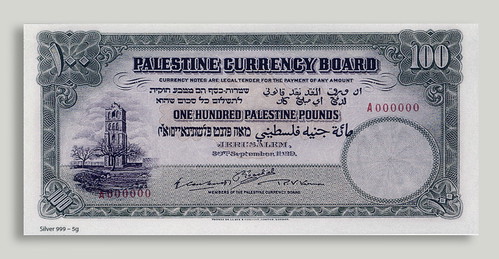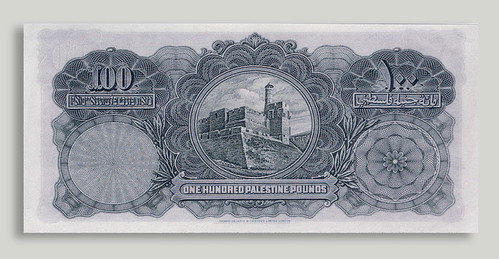
PREV ARTICLE
NEXT ARTICLE
FULL ISSUE
PREV FULL ISSUE
PALESTINE MANDATE BANKNOTES IN THIN SILVERMel Wacks submitted this article about facsimiles in silver of rare Palestine Mandate banknotes. Thanks. -Editor  Collectors who have dreamed of adding the extremely rare 50 and 100 Pound Palestine Mandate banknotes to their collections can now do so ? sort of ? at a tiny fraction of the over $100,000 they have been bringing. That's thanks to precise 150 x 70 mm. facsimiles produced in paper-thin, flexible pure silver with a weight of 5 grams by the Israel Coins and Medals Corp., an official distributor for the Bank of Israel. The £50 note has sold for more than $100,000, and few bank notes from around the world come rarer than a Palestinian £100 ? only four are known to still exist. The 1927 Currency Ordinance of the Palestine Currency Board specified the denominations of the new notes as 500 mils, £1, £5, £10, £50, and £100. These were designed and printed by Thomas de la Rue in England. The Palestine Mandate's charter from the League of Nations required that the name "Palestine" be shown in English, Arabic, and Hebrew. The structures appearing on the notes have significance for Jews, Muslims and Christians. The 500 mil note pictures the Tomb of Rachel. Rachel was the second and favorite wife of Jacob, grandson of Abraham. During a journey from Shechem to Hebron, Rachel suffered a difficult labor while giving birth to their second son Benjamin: "And Rachel died, and was buried on the way to Ephrath, which is Bethlehem. And Jacob set a pillar upon her grave" (Genesis 35:19-20). The front of the £5, £10, £50, and £100 Palestine Mandate notes feature a vignette of the Tower of Ramla. The tower was built in the 13th century by the Mamluk sultan al-Zahir Baybars to celebrate his eviction of the Crusaders from Ramla in 1268. The front of the £1 note banknote pictures one of the most prominent features of Jerusalem ? The Dome of the Rock. This important Muslim mosque stands atop the ancient Jewish Temple Mount, the holiest Jewish site ? where Abraham was ordered to sacrifice Isaac.  The vignette on the back of all six denominations shows the Citadel and Tower of David. It is one of Jerusalem's most prominent landmarks, forming part of the Western Wall of the Old City. It was built on the site believed to have been that of a fortress built by King David. The Citadel in various forms had long been part of Jerusalem's fortifications. In 37-34 BCE King Herod added three towers complete with battlements, turrets and connecting ramparts. When Titus destroyed Jerusalem in 70 CE the Roman Tenth Legion took over the Citadel. After the Arab conquest of Jerusalem in 638 CE, the Muslims refurbished the Citadel sufficiently for it to withstand the best assault the Crusaders could offer in 1099. During the Crusader period, the Tower of David was featured on coins issued by the Kingdom of Jerusalem. The Citadel was rebuilt by Suleiman the Magnificent in 1540, and a minaret was added in 1665. The name is perhaps derived from the Song of Songs (4:4): "Thy neck is like the tower of David builded for an armoury, whereon there hang a thousand bucklers, all shields of mighty men." The facsimile silver Palestine Mandate banknotes of £100, £50, £10, £5, £1 and 500 mils denominations are available individually for $49 each or just $249 for the complete set from the Israel Coins and Medals Corp. at www.israelmint.com. Wayne Homren, Editor The Numismatic Bibliomania Society is a non-profit organization promoting numismatic literature. See our web site at coinbooks.org. To submit items for publication in The E-Sylum, write to the Editor at this address: whomren@gmail.com To subscribe go to: https://my.binhost.com/lists/listinfo/esylum All Rights Reserved. NBS Home Page Contact the NBS webmaster 
|